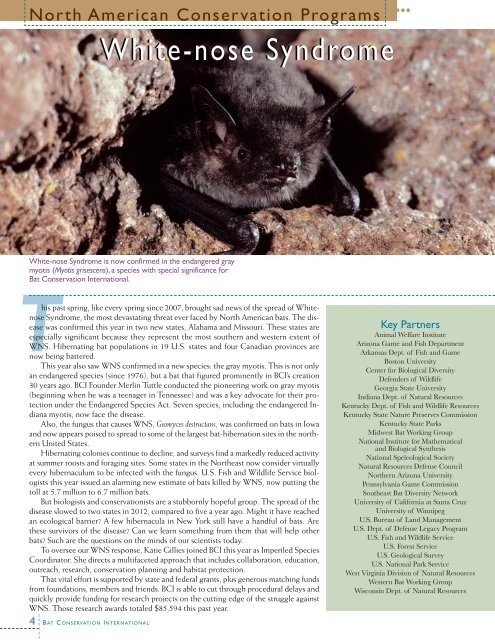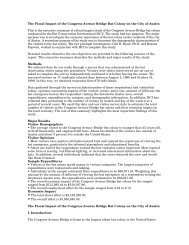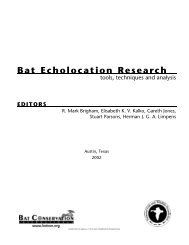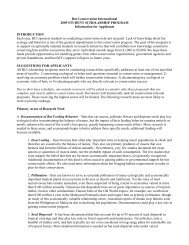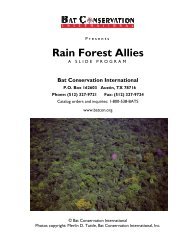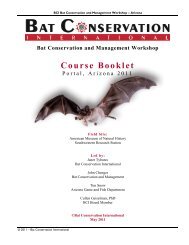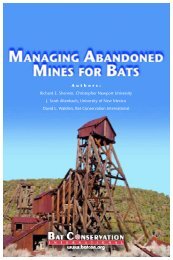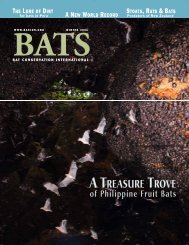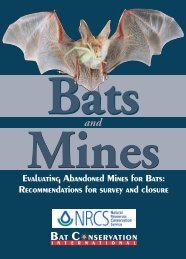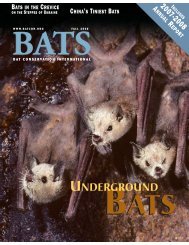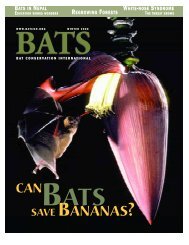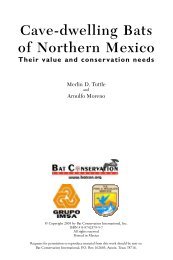Annual Report_09-10 - Bat Conservation International
Annual Report_09-10 - Bat Conservation International
Annual Report_09-10 - Bat Conservation International
Create successful ePaper yourself
Turn your PDF publications into a flip-book with our unique Google optimized e-Paper software.
north american <strong>Conservation</strong> Programs<br />
White-nose syndrome<br />
©MERLIN D. TUTTLE, BCI / 8553<strong>10</strong>1<br />
White-nose Syndrome is now confirmed in the endangered gray<br />
myotis (Myotis grisescens), a species with special significance for<br />
<strong>Bat</strong> <strong>Conservation</strong> <strong>International</strong>.<br />
This past spring, like every spring since 2007, brought sad news of the spread of Whitenose<br />
Syndrome, the most devastating threat ever faced by North American bats. The disease<br />
was confirmed this year in two new states, Alabama and Missouri. These states are<br />
especially significant because they represent the most southern and western extent of<br />
WNS. Hibernating bat populations in 19 U.S. states and four Canadian provinces are<br />
now being battered.<br />
This year also saw WNS confirmed in a new species: the gray myotis. This is not only<br />
an endangered species (since 1976), but a bat that figured prominently in BCI’s creation<br />
30 years ago. BCI Founder Merlin Tuttle conducted the pioneering work on gray myotis<br />
(beginning when he was a teenager in Tennessee) and was a key advocate for their protection<br />
under the Endangered Species Act. Seven species, including the endangered Indiana<br />
myotis, now face the disease.<br />
Also, the fungus that causes WNS, Geomyces destructans, was confirmed on bats in Iowa<br />
and now appears poised to spread to some of the largest bat-hibernation sites in the northern<br />
United States.<br />
Hibernating colonies continue to decline, and surveys find a markedly reduced activity<br />
at summer roosts and foraging sites. Some states in the Northeast now consider virtually<br />
every hibernaculum to be infected with the fungus. U.S. Fish and Wildlife Service biologists<br />
this year issued an alarming new estimate of bats killed by WNS, now putting the<br />
toll at 5.7 million to 6.7 million bats.<br />
But biologists and conservationists are a stubbornly hopeful group. The spread of the<br />
disease slowed to two states in 2012, compared to five a year ago. Might it have reached<br />
an ecological barrier? A few hibernacula in New York still have a handful of bats. Are<br />
these survivors of the disease? Can we learn something from them that will help other<br />
bats? Such are the questions on the minds of our scientists today.<br />
To oversee our WNS response, Katie Gillies joined BCI this year as Imperiled Species<br />
Coordinator. She directs a multifaceted approach that includes collaboration, education,<br />
outreach, research, conservation planning and habitat protection.<br />
That vital effort is supported by state and federal grants, plus generous matching funds<br />
from foundations, members and friends. BCI is able to cut through procedural delays and<br />
quickly provide funding for research projects on the cutting edge of the struggle against<br />
WNS. Those research awards totaled $85,594 this past year.<br />
Key Partners<br />
Animal Welfare Institute<br />
Arizona Game and Fish Department<br />
Arkansas Dept. of Fish and Game<br />
Boston University<br />
Center for Biological Diversity<br />
Defenders of Wildlife<br />
Georgia State University<br />
Indiana Dept. of Natural Resources<br />
Kentucky Dept. of Fish and Wildlife Resources<br />
Kentucky State Nature Preserves Commission<br />
Kentucky State Parks<br />
Midwest <strong>Bat</strong> Working Group<br />
National Institute for Mathematical<br />
and Biological Synthesis<br />
National Speleological Society<br />
Natural Resources Defense Council<br />
Northern Arizona University<br />
Pennsylvania Game Commission<br />
Southeast <strong>Bat</strong> Diversity Network<br />
University of California at Santa Cruz<br />
University of Winnipeg<br />
U.S. Bureau of Land Management<br />
U.S. Dept. of Defense Legacy Program<br />
U.S. Fish and Wildlife Service<br />
U.S. Forest Service<br />
U.S. Geological Survey<br />
U.S. National Park Service<br />
West Virginia Division of Natural Resources<br />
Western <strong>Bat</strong> Working Group<br />
Wisconsin Dept. of Natural Resources<br />
4 B aT C o n s e rvaT i o n i n T e r n aT i o n a l


